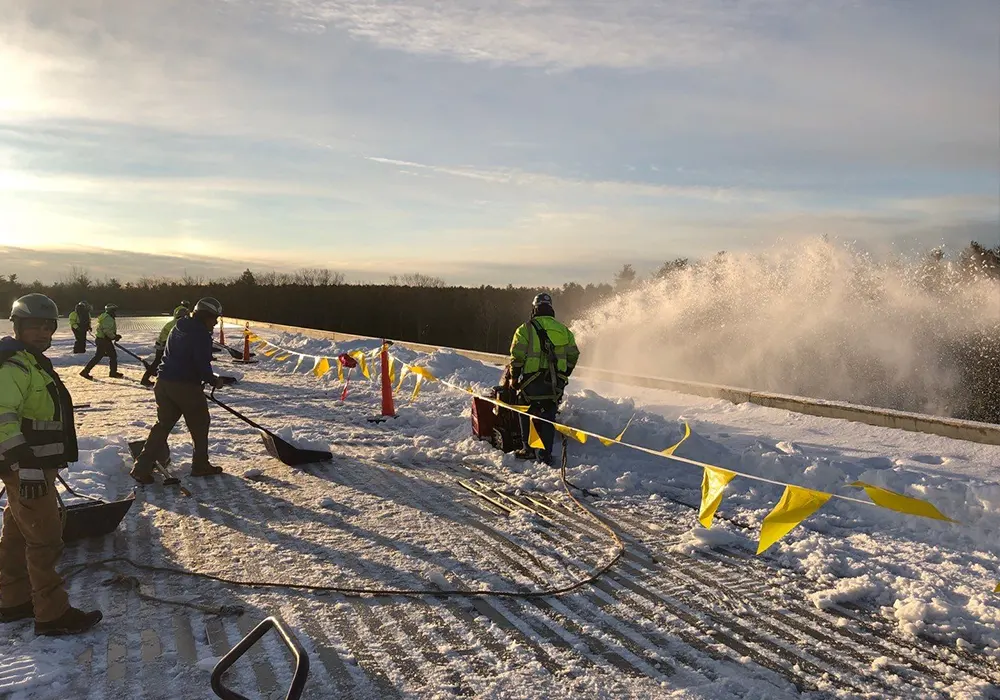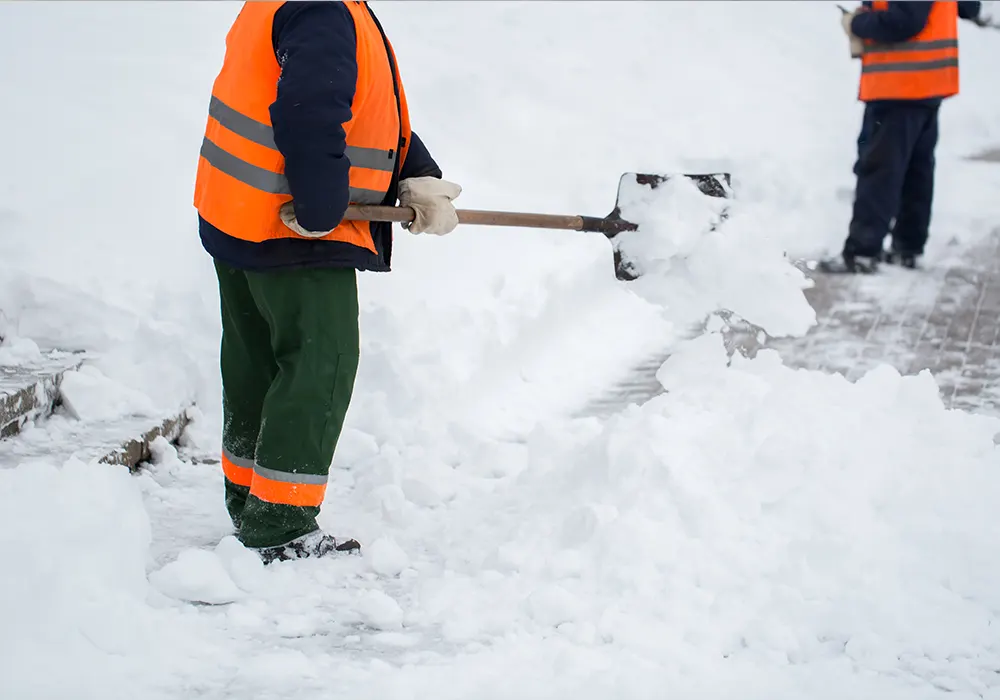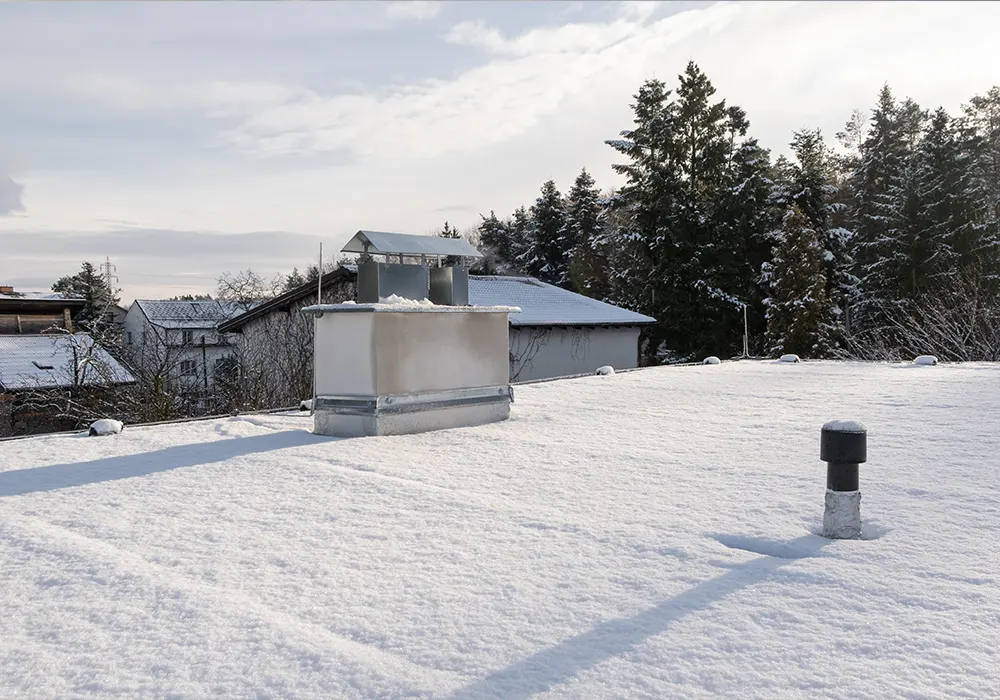Snow Removal

Efficient Snow Removal
While your commercial roof is protecting you, your employees and your equipment from the elements, it is also shouldering the burden of snow accumulation on your roof. The weight of the snow puts a great deal of stress on your roof and thus, your building’s structure.
In the winter season, your roof requires special attention — snow and ice removal and preventive measures. Northeast Industrial Roof offers professional and efficient snow removal services that will help keep your commercial building safe for your customers and employees so that you can continue with business as usual.
Why Use Our Snow & Ice Removal Service?
If you’re in a location in which you experience heavy or frequent snows during the winter months, snow and ice can wreak havoc on your business. It can cause customers to stay home rather than going out, resulting in lower revenue, prompt employees to stay home, which impacts productivity, or even cause accidents that you’re liable for. But the worst impact that winter weather can have on your business is the potential for structural damage caused by the weight of accumulated snow and ice.
Prompt and effective snow removal is crucial to keeping your business running as smoothly as possible during harsh winter weather. Failing to remove snow can result in the aforementioned negative impacts, and trying to remove snow from your roof yourself can result in damage to the roof and its peripheral components (such as skylights or HVAC units) as well as severe bodily injury.
Safe & Proper Snow RemovalNortheast Industrial Roof

- Proper snow removal training for all of our roofers.We specialize in large, flat roofs as well as low-slope commercial roofs.
- Professional de-icing.We’ll use a product that is compatible with your roof’s membrane so that ice can be safely removed without damaging the roof.
- Underdeck inspection.Our roofers will pay special attention to water deflection to ensure that water is not finding its way into the building.
- Place flag markersto ensure skylights and other projections are not damaged by snow removal procedures
- Place caution signsaround any areas of possible falling snow or ice to prevent injuries or damages.
- Provide clear passageto all drains to eliminate the pooling of melting snow and ice on the roof membrane.
Snow & Your RoofWhat You Should Know
- How much weight your structure can sustain without risking serious damage.When and how the building was constructed, the materials your building is constructed from and what roofing materials you have all have an impact on your structure’s integrity.
- How much snow weighs.One inch of wet, dense snow roughly equates to 1.66 pounds per square foot. That means six inches of snow will result in 9.96 extra pounds per square foot that your structure has to sustain. For a roof that is 50,000 square feet, that’s equal to about 498,000 additional pounds – roughly 250 tons – of load on your roof. That’s about the weight of 125 passenger vehicles.
- How snowdrifts disrupt the weight distribution on the roof.Drifts effectively place a disproportionate amount of weight on some parts of the roof, increasing the risk of serious damage or failure.
- How melting snow affects your roof’s drainage.Melting snow, when it refreezes, can cause ice dams, which can slow or stop proper drainage. This will result in excessive weight on parts of the roof where the water pools.

Commercial Snow Removal FAQs
Q:
What is a snow load?
A:
The snow load refers to the downward pressure applied to the roof by the weight of accumulated ice and snow. If the snow load exceeds the amount of weight the building is designed to withstand, the roof could suffer damage or even collapse. Snow drifting can cause uneven snow load, which places weight unevenly on the roof, potentially causing a cascading series of damage to the building.
Q:
What are the warning signs of excessive snow load?
A:
Some of the most common signs of structural damage include cracking, sudden leaking, or shifting of interior walls. The presence of any of these should prompt an immediate response in the form of a thorough roof inspection. Waiting to schedule an inspection can further compromise the roof and result in significant damage or even total failure. A few other signs that your roof needs attention include: Excessive icicles forming over the edge of the roof, Cracked ceilings or walls, Broken or shifted ceiling tiles, Snow or ice falling from the roof (more than what is normal) and Buckling walls or beams.
Q:
What are ice dams?
A:
When snow or ice melts, it will collect at the edges of a roof and around penetrations, curbs and parapets. When it refreezes in place, an ice dam forms, preventing future runoff from draining properly, and the cycle continues until the added weight and stress from pooling water and accumulated ice ultimately causes roof failure. Ice is about eight times heavier than snow and much more difficult to remove effectively without damaging the roof, so it’s best to keep up with snow removal to avoid worsening the problem.
Q:
How do I know when to remove snow?
A:
It’s important to know the snow load your building can tolerate. When you know that information, you can track the snowfalls in your area and know when your roof needs to be cleared. If you aren’t sure, use visual cues. Before snow falls, place conspicuous markers on roof curbs, skylights, roof vents, HVAC units and chimneys. This will help roofers avoid the hazards, preventing damage and potential injury, and will also provide you a way to visually determine how much snow is accumulating on the roof and when you should call for snow removal.
Leave all rooftop work, including snow removal, to professionals. We’re experienced and educated regarding the physics of ice and snow on a flat or low-slope roof, safe de-icing, removing snow without damaging roofing components, and performing these tasks without stepping through the roof or suffer bodily injury.
